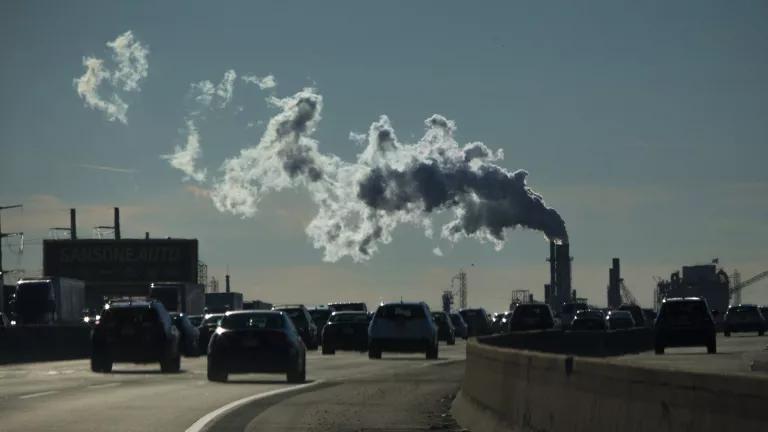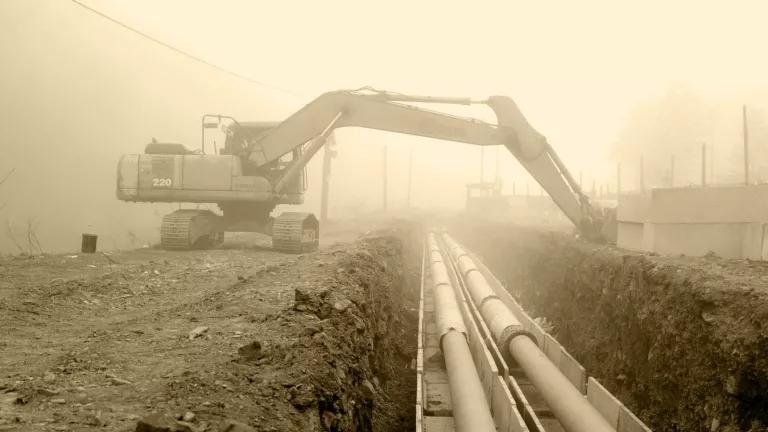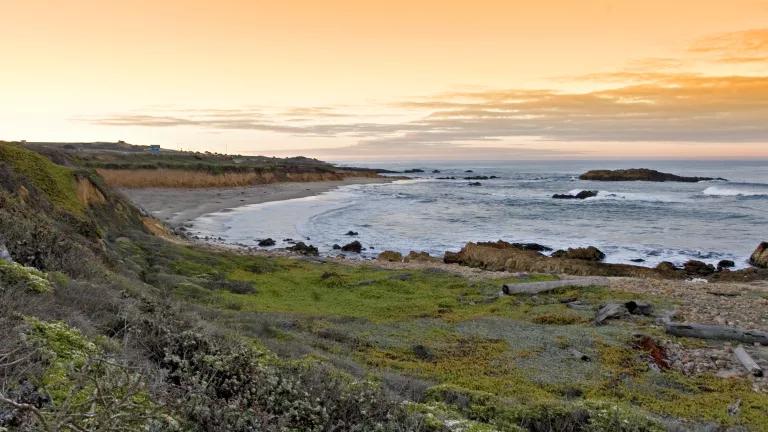
In November 2015, President Obama announced the rejection of the proposed Keystone XL tar sands pipeline. The announcement ended a six year fight between environmentalists, Alberta’s oil industry, and pro-oil lawmakers that brought the spotlight onto tar sands oil and the threat it poses to our shared climate and environment. For TransCanada, the company behind the Keystone XL proposal, the pipeline’s rejection was a blow. But now they’re back with an even bigger, even riskier proposal that could threaten more people and more resources than even the Keystone XL behemoth would have.
TransCanada’s latest scheme—known as the Energy East pipeline—is 35% larger than Keystone XL and is designed to carry up to 1.1 million barrels per day of tar sands oil from Northern Alberta to refineries in Quebec and a seaport in Saint John, New Brunswick. From there, nearly 300 oil supertankers would be loaded every year for transit along the Atlantic and Gulf Coasts in order to reach refineries in Louisiana and Texas. And while the concept of Energy East has been around since at least 2013, TransCanada did not submit its full project application to Canadian regulators until nearly the same moment it sued the U.S. government for $15 billion under NAFTA for prospective damages related to the Keystone XL rejection.
In a new report titled Tar Sands in the Atlantic Ocean: TransCanada’s Proposed Energy East Pipeline, NRDC reveals the specifics of the project and the significant threats it poses to U.S. coastal resources ranging from Maine, to the Florida Keys, to the Gulf of Mexico. As with Keystone XL, the proposed Energy East tar sands pipeline would pose a long-lasting threat to the global climate; introduce the risk of an un-cleanable tar sands oil spill, this time along thousands of miles of Canadian and U.S. coastlines, and undermine the survival of several iconic and endangered species, this time marine mammals that depend on ecosystems up and down the eastern seaboard. Along the way, an accident involving Energy East tankers carrying tar sands crude could cause significant harm to East Coast fisheries, not to mention the multi-billion dollar coastal tourism industry.

Major Threats: Sinking Oil and Climate Change
Since at least 2010, when up to 1 million gallons of tar sands oil (in the form of diluted bitumen) spilled into the Kalamazoo River from a ruptured pipeline, the behavior of tar sands spills into water have been front and center in debates about the risks of transporting tar sands crude. In that spill, a large portion of the spilled tar sands sunk, coating nearly 40 miles of the river bottom in a sticky mess that took five years, repeated dredging and a reported $1.2 billion to clean up. Today, long term monitoring of the river has been put in place because spill responders were unable to remove all of the spilled tar sands from the river’s bottom.
In early 2016, the National Academy of Sciences released the results of a two year study of the best available science on the environmental fate of tar sands diluted bitumen when spilled. The findings of the expert panel confirmed that what happened in Kalamazoo was no fluke: tar sands diluted bitumen is fundamentally different than other crude oils and when it is spilled into water, large quantities can be expected to sink, creating spill impacts that cannot be addressed by current spill response techniques and technologies.
The implications of the NAS’s finding for our coastlines if Energy East were ever built are clear: the proposal would create a waterborne pipeline of supertankers traveling the Eastern Seaboard and through the Gulf Coast carrying a toxic substance that cannot be removed from the environment in the case of an accident. In doing so, commercial and sport fisheries worth billions of dollars annually would be put at risk from submerged and sunken oil, including New England and Atlantic Canada’s iconic lobster fisheries. Elsewhere, coastal economies from Maine to Florida to Texas could be decimated by the long-lasting effects of an ocean spill that cannot be mitigated by existing oil spill response methods.

Globally, Energy East would lock in an enormous piece of high-carbon infrastructure that would operate for decades to come. The implications for our shared climate are significant—estimates based on the types of oil Energy East is expected to move place annual lifecycle emissions (from production, transport, refining, and use) at a staggering 256 million metric tons of carbon pollution. While most of those emissions take place outside of Canada, the pipeline’s total contribution to global climate pollution is equivalent to 35% of Canada’s total annual emissions. That’s the annual emissions of every vehicle on the road in Germany (54 million cars). In other words, as the world begins making the tough decisions needed to avoid climate disaster, there is no place for energy projects with the long term climate impacts that Energy East would have.
Threats to North American Icons
Once tar sands oil is loaded onto supertankers in Saint John, New Brunswick, the tankers would use a pathway that could imperil numerous Atlantic icons. For marine mammals that breed and migrate in areas located along the entire expected route of Energy East’s tankers, the threats are serious: ocean noise, ship strikes, and the risk of an oil spill could all spell disaster. This is particularly true for two whale species—the North Atlantic right whale and the fin whale—both of which are found in the Bay of Fundy where Energy East tankers would be loaded. The North Atlantic right whale is one of the most endangered species of whale on the planet, with estimates placing the total population at only 450 individuals. The fin whale, which is the world’s second largest whale, is similarly endangered. Each species is at great risk of ship strikes, which can cause serious injuries or death; deafening underwater noise generated by massive ocean vessels, which can hinder their ability to communicate, hunt, and navigate; and oil spills, which not only introduce toxic substances into the water, but could also disrupt the availability of critical food sources.

Along our shorelines, places like Acadia National Park in Maine and the Florida Keys National Marine Sanctuary would also be imperiled by the tar sands tanker traffic created by Energy East. For Acadia, which lies only 100 miles south of Energy East’s endpoint and a short distance from where its tankers would begin their southward journey, its granite shorelines and fragile ecosystems are especially vulnerable to the threats posed by an Energy East tanker accident. This is equally true further south, where Energy East tankers would be expected to travel within 15 miles of the Florida Keys. The Keys, which are home to the world’s third largest barrier reef, are not only one of the U.S.’s best known tourist destinations, they also play a key role in protecting mainland Florida from erosion and the negative impacts of saltwater incursion. The threat of a tar sands spill near this critical resource cannot be ignored, with possible impacts ranging from destruction of irreplaceable coral reefs to the oiling of beaches along Florida’s eastern coast due to northbound ocean currents.
Keeping the Threat at Bay: Solutions for Addressing Risks Created by Energy East
Energy East has been proposed without the tar sands industry doing anything to show regulators or first responders that it understands how to clean up spills of its most common product—diluted bitumen—into water. In fact, one of their favorite talking points is to just say, “oil is oil.” Not only have real world experiences in Kalamazoo, Michigan and elsewhere shown this to not be the case, the NAS’s comprehensive report on tar sands diluted bitumen has blown this talking point completely out of the water.
To counter the threats posed by Energy East—and any other piece of infrastructure designed to move tar sands diluted bitumen to water for ocean or river transport—several important steps are needed. First, the U.S. must move for a tar sands tanker moratorium on U.S. navigable waters. Without the tools, knowledge, or techniques necessary for cleaning up a spill of tar sands diluted bitumen, our first responders must not be handed the task of facing the impossible while our marine resources suffer the consequences. A tar sands tanker moratorium would create the time necessary to either develop the technology needed to mitigate the likely impacts of a tar sands oil spill into water or, ideally, incentivize the growth and deployment of economic alternatives necessary to end the expansion of tar sands production in Northern Alberta and obviate the need for infrastructure like Energy East altogether.
As this moratorium is put in place, the U.S. must also move to engage in the regulatory reviews of projects designed to move significant quantities of tar sands oil into U.S. waters and on to U.S.-based refineries. Without meaningful engagement by our environmental regulators and those agencies charged with protecting marine species and keeping our coastlines safe, the oil industry would be given carte blanche to place thousands of miles of U.S. coastlines, not to mention the species and fisheries located offshore, at risk without any consideration of what an accident could mean for critical U.S. resources. Doing so places all of us at risk and leaves our first responders unprepared—indeed, unaware—of the types of threats they may confront if a project like Energy East were to ever be built




